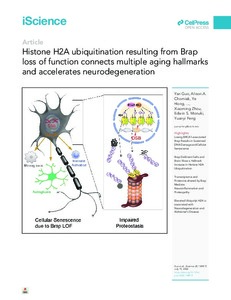Histone H2A ubiquitination resulting from Brap loss of function connects multiple aging hallmarks and accelerates neurodegeneration
Guo Yan; Chomiak Alison A; Hong Ye; Lowe Clara C; Kopsidas Caroline A; Chan Wen-Ching; Andrade Jorge; Pan Hongna; Zhou Xiaoming; Monuki Edwin S; Feng Yuanyi
Histone H2A ubiquitination resulting from Brap loss of function connects multiple aging hallmarks and accelerates neurodegeneration
Guo Yan
Chomiak Alison A
Hong Ye
Lowe Clara C
Kopsidas Caroline A
Chan Wen-Ching
Andrade Jorge
Pan Hongna
Zhou Xiaoming
Monuki Edwin S
Feng Yuanyi
Elsevier
Julkaisun pysyvä osoite on:
https://urn.fi/URN:NBN:fi-fe2022091258532
https://urn.fi/URN:NBN:fi-fe2022091258532
Tiivistelmä
Aging is an intricate process characterized by multiple hallmarks including stem cell exhaustion, genome instability, epigenome alteration, impaired proteostasis, and cellular senescence. Whereas each of these traits is detrimental at the cellular level, it remains unclear how they are interconnected to cause systemic organ deterioration. Here we show that abrogating Brap, a BRCA1-associated protein essential for neurogenesis, results in persistent DNA double-strand breaks and elevation of histone H2A mono- and poly-ubiquitination (H2Aub). These defects extend to cellular senescence and proteasome-mediated histone H2A proteolysis with alterations in cells' proteomic and epigenetic states. Brap deletion in the mouse brain causes neuroinflammation, impaired proteostasis, accelerated neurodegeneration, and substantially shortened the lifespan. We further show the elevation of H2Aub also occurs in human brain tissues with Alzheimer's disease. These data together suggest that chromatin aberrations mediated by H2Aub may act as a nexus of multiple aging hallmarks and promote tissue-wide degeneration.
Kokoelmat
- Rinnakkaistallenteet [27094]
